Product footprint reporting for chemical companies
Abstract
In the era of environmental sustainability, firms are put under pressure from the political and customers’ sides to act, particularly those in high feedstock and energy consuming sectors, like the chemical industry. A trend towards greener products is inevitably reaching intermediate sectors, so that sustainability reporting at product level arises as a necessity. Profound product footprint calculation lays the foundation for the definition of dedicated reduction targets and the development of climate-neutral products. In this article, we outline and compare two product footprint reporting frameworks: GHG Protocol’s Product Standard and the EU Commission’s Product Environmental Footprint, with the goal to provide firms in the chemical industry with guidance and insights on which aspects are more relevant and critical.
1 Introduction
Nowadays, climate neutrality, circular economy, and green energy are common concepts to many. This is especially true in industrial sectors with relevant impact on the environment caused by, e.g., particularly high feedstock and energy consumption or emissions intensity. The chemical industry can surely be counted among these and actions are already being initiated to prepare for the upcoming changes that are indispensable to achieve environmental neutrality.
Rising awareness for sustainability is gaining influence in social, political, and economic spheres (Verband der Chemischen Industrie, 2021). Customers’ increasing requests for sustainable products is only one example for this trend. Furthermore, the challenges of combating climate change, preserving natural resources and establishing a circular economy have been enshrined in international agreements such as the Paris Agreement and the European Green Deal. Within the latter, the European Commission published the „Chemicals Strategy towards a toxic-free environment“ (in the following “Chemicals Strategy”) in October 2020 which encourages, among others, a substantial revision and tightening of the REACH (1) and CLP (2) regulations to achieve European climate neutrality by 2050 and strengthen human health aspects based on sustainability assessments for chemical substances and products (European Commission, 2020). To meet these political targets, the chemical industry is dependent on the development of appropriate methods and metrics for the identification, definition, and quantification of sustainability key performance indicators (KPIs) especially at the product level. However, assessing a company’s or product’s environmental impact is only the first, fundamental step towards climate neutrality: companies should exploit this information to identify the main drivers and possibly act on it, reducing their impact in order to achieve international and company-set targets.
Several guidelines and standards, like the International Reference Life Cycle Data System (ILCD) Handbook and assorted ISO standards (e.g., ISO 14040, 14044, 14067), have been developed to enable a comprehensive assessment of sustainability key performance indicators. This article provides chemicals companies with some orientation on how to compute and report environmental footprints at product level by performing a theoretical comparison of two selected standards for product footprint accounting, Greenhouse Gas (GHG) Protocol’s Product Standard and European Commission’s Product Environmental Footprint (PEF).
In Section 2 we introduce the concept of life cycle assessment (LCA) and provide some basic facts about the origins of the two standards. In Section 3 each of these is outlined, GHG Protocol’s Product Standard in Section 3.1 and the PEF in Section 3.2. In Section 3.3 we focus on the direct comparison of the two approaches and outline crucial aspects for chemicals companies.
Finally, we give an overview of the discussed topics and an outlook on what lies ahead for the chemical industry in the next years in Section 4.
(1) European Union’s regulation on “Registration, Evaluation, Authorisation and Restriction of Chemicals” (EC No 1907/2006)
(2) European Union’s regulation on “Classification, Labelling and Packaging” (EC No 1272/2008)
2 Determining sustainability criteria
Since chemical products are typically intermediates that are further processed in numerous downstream industries, their sustainability is a fundamental ingredient for the overall sustainability achieved after subsequent processing. Famously, a shift towards renewable resources and energy as well as the development and use of recycling processes is imperative to meet the objectives of international goals like European climate neutrality in 2050. Necessary prerequisites are the development and establishment of innovative technologies, e.g., for the production of renewable energies and green hydrogen. Tracking of improvements is essential to achieve transparency towards the general public, investors, employees, customers and regulators. However, the initial assessment of a product footprint marks the central starting point for all further actions. To this end, LCA has been established as a common concept for the determination of product footprints.
Life cycle assessment
LCA allows to derive a product footprint, which provides a comprehensive overview of a product environmental profile and, furthermore, forms a solid basis for the identification of impact hotspots and reveals potential for sustainable product optimization. The International Organization of Standardization (ISO) describes the concept of LCA as follows: “LCA considers the entire life cycle of a product, from raw material extraction and acquisition, through energy and material production and manufacturing, to use and end of life treatment and final disposal. Through such a systematic overview and perspective, the shifting of a potential environmental burden between life cycle stages or individual processes can be identified and possibly avoided.” (International Organization for Standardization, 2006, Section 4.1.2)
Following the ISO definition, an LCA should ideally comprise the whole life cycle of the observed entity, even beyond the mere area of control of the reporting firm. Negligence of any part of the life cycle would at the very least weaken the assessment, not revealing the whole picture of the entity’s environmental impact. Nevertheless, an assessment on activities beyond the control of the reporting firm will inevitably require assumptions and estimates on the input quantities, weakening the quality of data and, hence, the assessment itself. Due to the manifold processing and usage profiles of chemicals products, this is particularly challenging for chemicals companies.
Various methods and guidelines have already been developed to provide orientation and standardization for accounting and reporting of environmental impacts. In the following, we take a closer look at two approaches for the assessment of product footprints and discuss some associated challenges for chemicals companies.
2.1 Two frameworks for sustainabilty assessment at product level
Both the GHG Protocol and the European Commission developed frameworks for sustainability assessment at product level. While the GHG Protocol is an already recognized international standard (3), the PEF is currently being further developed by the European Commission to be prospectively integrated into the European regulatory framework.
(3) Due to the fact that many chemicals companies and virtually all large listed international companies refer to the Corporate Standard for calculation and disclosure of their corporate carbon footprint (CCF) (Umweltbundesamt, 2012).
2.1.1 GHG Protocol – Product carbon footprint
The GHG Protocol is a global initiative coordinated by the World Resource Institute (WRI) and the World Business Council for Sustainable Development (WBCSD) developing guidelines for the measurement, quantification, balancing, and reporting of greenhouse gas emissions at both product (referred to as “Product Standard”) and company level (referred to as “Corporate Standard”) in close cooperation with NGOs, industry associations and governments. Back in 2011, the GHG Protocol published its first guidance on carbon footprint accounting at product level (product carbon footprint, PCF).
2.1.2 European Commision – Product environmental footprint
In 2011, the European Commission started an initiative to develop a standardized approach for the determination of the environmental impact of products and services based, inter alia, on existing standards like ISO 14040 and ISO 14044. A similar initiative for the determination of the environmental impact of organizations, the Organisation Environmental Footprint (OEF), has also been conducted. However, an initial version of the PEF has been published in 2013, followed by a pilot phase to test its feasibility in practice and going over into the transitions phase.
3. Product footprint calculation for chemicals
Although Product Carbon Footprint (PCF) and Product Environmental Footprint (PEF) share many commonalities in their approach like the application of LCA, one major difference emerges from their overall scope. Whereas the PCF focusses on climate change solely, the PEF considers a much broader spectrum of environmental impacts. Keeping that in mind, we now take a closer look at some of the challenges arising when applying the two approaches to chemicals.
3.1 PCF assessment – The GHG Protocol´s product standard
A PCF records the total sum of greenhouse gas emissions generated by a selected product throughout its entire life cycle and consolidates the result into a single figure in CO2 equivalent (CO2e). In line with the resolutions of the Kyoto Protocol, the Product Standard requires to take at least the following six greenhouse gases into account: carbon dioxide (CO2), methane (CH4), nitrous oxide (N2O), hydrofluorocarbons (HFCs), perfluorocarbons (PFCs), and sulfur hexafluoride (SF6). Overall, PCF determination according to the Product Standard can be summarized into the following main steps:
- Boundary setting and scope definition,
- Compilation of an emissions inventory and data collection,
- Calculation of inventory results and uncertainty assessment, and
- Optimization and interpretation.
Overall, the GHG Protocol proposes nine distinct steps. As the intention of this article is a brief overview, some steps have been summarized, and those with minor relevance to our purpose have been omitted (e.g., assurance). Please refer to the original publication for the complete list of steps proposed by the GHG Protocol (2011).
3.1.1 Boundary setting and scope definition
First and foremost is the definition of business objectives and system boundaries to assess which activities shall be covered by the planned PCF assessment. This includes the definition of the product to be observed, the life cycle stages that are to be considered, and production sites relevant for the manufacturing of the selected product. Moreover, the overall objectives of the assessment should be sensibly selected depending on the target audience (internal vs. external).
The GHG Protocol framework distinguishes between three scopes of emissions which are in general applicable for both study types, the corporate carbon footprint (CCF) and PCF quantification (cf. Figure 1). For further details on the scope definitions please refer to the guideline of the GHG Protocol (2004, p. 25).
In principle, the Product Standard states that all life cycle stages from cradle to grave shall be analysed in a PCF study (cf. Figure 1). Because of usually diverse areas of application of chemical products, it is almost impossible to carry out a well-founded assessment of all life cycle phases beyond the control of the reporting firm. Too many generic assumptions about further processing, use, lifetime, and disposal may lead to a rough approximation resulting in an impairment of the PCF validity. Therefore, manufacturers of intermediate products can reasonably pursue the cradle-to-gate approach narrowing down the observed life cycle phases to the production of raw materials and manufacturing of the intermediate product until the reporting company’s exit gate (cf. Figure 1). However, an assessment of the gate-to-grave part can still be made on a qualitative level, as proposed by the European Commission (2013, p. 44).
Another mandatory step is the definition of a unit of analysis which shall reflect a meaningful unit of the product of interest. For final products it shall be given as a functional unit allowing a measurement of the function of a product and thus, facilitating the comparison of the impact of different products at a functional level. An example for functional unit is the amount of PET granulate that is needed to produce a water bottle for transportation of 1 L of water.
Since chemical products usually end up in numerous applications, the specification of a functional unit is hardly possible or even meaningful. The Product Standard states that the specification of a simple unit of analysis, e.g., in kg of product, suffices in this case.
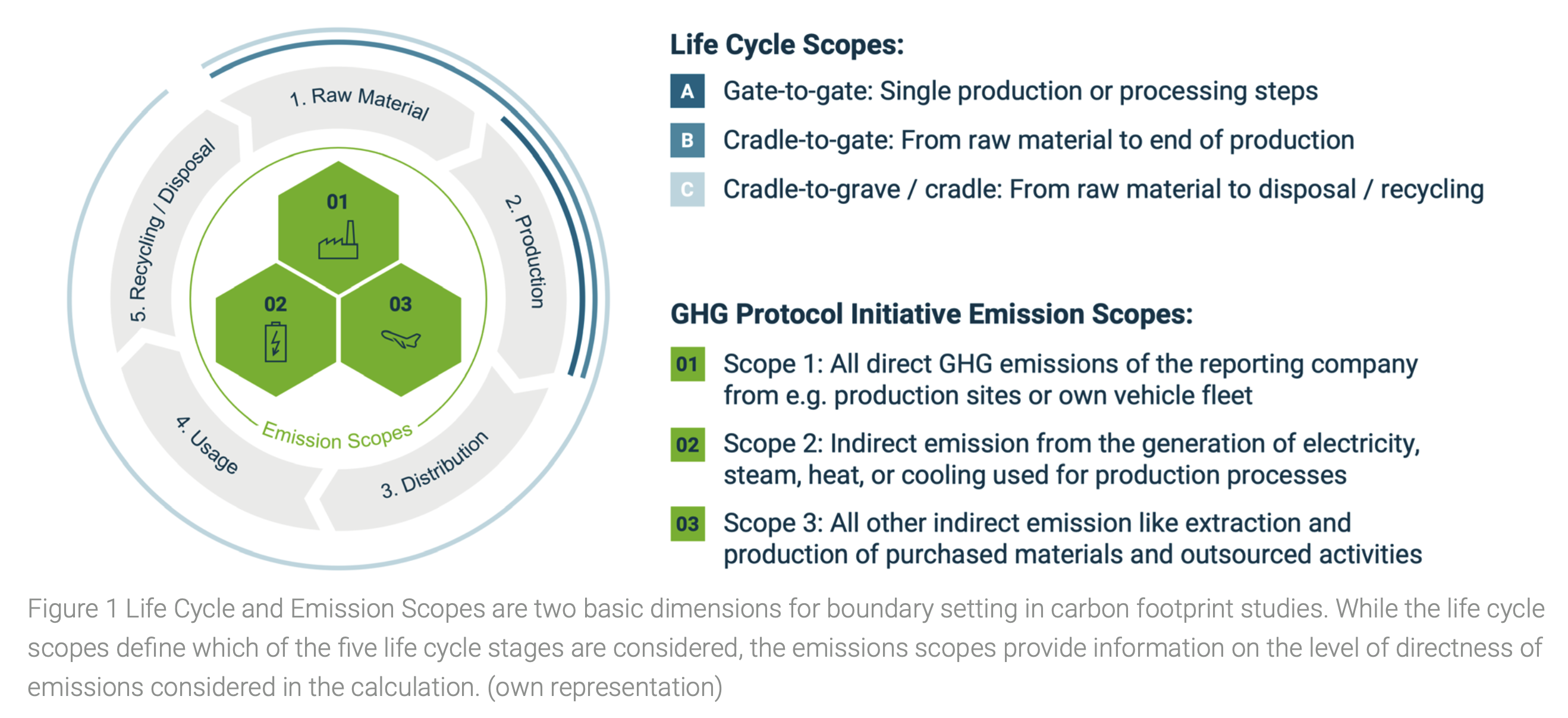
3.1.2 Emissions inventory and data collection
Once system boundaries and unit of analysis are defined, the compilation of an emissions inventory is performed. A process flow chart shall be used to identify relevant inventory items within the system boundaries, reaching from processes and activities over consumables and raw materials to waste. The comprehensiveness of the emissions inventory is a critical factor for the overall quality of the PCF and forms the basis for subsequent data collection.
Three types of data serve as input for the PCF calculation:
- Direct emission data: emissions directly released during a process or activity which can be determined e.g., by direct measurement or stoichiometry of the underlying chemical reaction;
- Activity data: particular amounts and units describing each activity causing emissions, emerging either from financial data (e.g., the amount of electricity purchased for the production process in EUR) or process data (e.g., the amount of electricity consumed by production process in kWh);
- Emission factors: factors applied for the conversion of activity data into CO2e.
The preferred way to obtain direct emissions and activity data is through collection from specific processes in the studied product life cycle, the so-called primary data. In case of insufficient infrastructure for the measurement or collection of primary data, generic industry-specific values may be used, the so-called secondary data.
Regardless of whether primary or secondary data are used, the assessment of data quality in terms of technological, geographical, and temporal representativeness, as well as completeness and reliability, is always obligatory. The availability of high-quality data sets for activity data and emission factors remains a central challenge to achieve a high-quality PCF.
Ultimately, the acquisition of emission and activity data based on the company’s individual production processes forms the most solid, tangible, and accurate foundation for PCF determination.
3.1.3 PCF calculation
The PCF calculation shall reflect a product’s impact on climate change over a time span of 100 years. Thus, the application of the most recent 100-year global warming potential (GWP) factors from the Intergovernmental Panel on Climate Change (IPCC) is mandatory. Emitted greenhouse gases for each activity are captured in emission factors. Finally, all activity data are multiplied by their respective emission factors and GWP factors and summed up to create the PCF.
However, multifunctional and highly interconnected chemicals production processes cause a high degree of complexity within the calculation step. For example, the energy used in a process must be distributed among the main and all co-products manufactured and further processes.
The most obvious distribution approach is direct allocation, i.e., the breakdown of emissions to different products through a certain metric based on, e.g., relations of their physical properties or economic values. However, the Product Standard states that allocation should be avoided wherever possible and proposes three different methods for doing so (GHG Protocol, 2011, p. 60 – 77):
- Process subdivision: Break down the multifunctional process into distinct sub-processes that do not rely on allocation anymore (cf. Figure 2).
- Redefining the unit of analysis or functional unit: Circumvent allocation by inclusion of the co-product or its function into the assessment, respectively.
- System expansion: Directly determine the co-product emission share if a comparable process for the exclusive production of the co-product is known.
Allocation avoidance methodologies are often insufficient for obtaining robust and reliable PCF results and thus, allocation is indispensable for PCF studies of many chemical products. In this case, the underlying physical relationship of product and co-product should be used in the first instance to allocate the shares of emissions to the outputs of the multifunctional process.
In case the physical relationship of the product and co-product cannot be established or is not known (4), economic allocation may be applied if the market values of the product and co-products reflect the respective emission shares at the point where they leave their common process. Additionally, the market values of the co-products shall not be significantly influenced by brand effects or other factors that cause a distortion of the emission shares.
The Product Standard also allows for the use of further relationships between process outputs, provided they reflect an adequate allocation of emission shares regarding their impact on climate change. This proposed application of allocation is also consistent with the requirements of ISO 14044 (International Organisation for Standardization, 2006). Moreover, in case it is not obvious that one allocation procedure is more suitable than another, at least two different allocation approaches shall be applied and compared to allow for a justified and sound identification of the most appropriate one.
Methods used for allocation (for avoidance thereof) shall be anyhow disclosed and consistent within one PCF study or between similar products and furthermore thoroughly described and justified.

(4) For example, for multiple co-products that do not have one common, appropriate physical allocation factor regarding the unit of analysis.
3.1.4 Interpretation of results and setting of reduction targets
The interpretation of PCF results aims to identify impact hotspots, enabling the derivation of optimization potential and emission reduction targets. Reporting guidelines further ensure extensive documentation for disclosure of the PCF results to provide transparency and traceability for stakeholders and customers. For more details on interpretation and optimization, please refer to GHG Protocol (2011).
3.1.5 Limitations of the product standard
The Product Standard provides a rather broad framework for the definition of system boundaries and scoping recommendations. For example, regarding definition of the unit of analysis or the respective functional unit. Usage of specific product rules (5) and sector guidelines is encouraged if available, reviewed by a reliable stakeholder group and not contradictory with the requirements of the Product Standard. As the application of product rules is not mandatory, PCF results are not necessarily comparable between companies, even if the considered product, the observed life cycle stages, and the underlying manufacturing processes as well as planned use and disposal are equal.
Developing product (group) specific criteria and assessment rules is one of the overarching aims of the European Commission’s PEF approach at which we now take a closer look.
(5) E.g., application of product category rules as they are defined by ISO 14015:2006 according to GHG Protocol (2011, p. 24-25)
3.2 PEF assessment – Holistic product environmental profile
The PEF approach aims to provide a standard in line with the already developed ones and, moreover, increase clarity, transparency, and traceability of product environmental impacts. Consumers will benefit directly from increased comparability and transparency, while a standardized approach can possibly reduce the evaluation and disclosure burden for companies.
Since the PEF is a multi-step approach following similar main steps as the Product Standard, the following paragraphs will only highlight significant differences between the two frameworks. A significant difference to the PCF is the development of so called “Product Environmental Footprint Category Rules” (PEFCRs) that provide additional guidance on PEF calculation steps for specific product categories. Details on PEFCRs are given at the very end of Section 3.2.
3.2.1 Boundary settings and scope definition
The overall scope of the PEF far exceeds that of the PCF. In addition to climate change, 13 further impact categories are measured and evaluated within a PEF study. Those categories include, e.g., ozone depletion and ecotoxicity for aquatic fresh water as well as ionizing radiation, acidification, and different types of resource depletion. Specific impact category indicators (e.g., CO2e for climate change or human exposure efficiency related to U-235 for ionizing radiation) and individual impact assessment methods are assigned to each impact category, leading to a more restrictive methodological framework compared to the GHG Protocol’s Product Standard.
Although a PEF aims for a holistic environmental assessment, the methodology also allows for application of combined approaches where only the cradle-to-gate part of the life cycle is analyzed quantitatively. This is especially relevant for the chemical industry as a producer of intermediate products.
In contrast to the Product Standard, the PEF Guide always requires the definition of a unit of analysis which “qualitatively and quantitatively describes the function(s) and duration of the product” (European Commission, 2013). Moreover, the definition should include the function or service provided, its extent, the expected level of quality, the lifetime of the product and its category.
Since a product category determines the population of comparable products, its definition significantly influences the PEF’s applicability. The definition of a product category should be restrictive enough for a meaningful product comparison while ensuring that the number of products is not too limited to guarantee a sufficient foundation for comparability within one category. To achieve this, the application of Classification of Products by Activity (CPA) codes (European Statistical Office, 2008) or the usage of a consumer-centric approach is recommended. The typically multifunctional range of applications for chemical products makes assignment to a single consumer centric product category nearly impossible, though.
3.2.2 Data collection and data quality
The usage of a process diagram is recommended for data collection to display all processes and activities within the defined system boundaries in a systematic and comprehensive way (cf. Figure 3). This facilitates the compilation of the mandatory inventory and a structured data acquisition in PEF studies.
In line with the Product Standard, collection of primary data is preferred in PEF assessments and particularly relevant if results shall be used for B2B or B2C communication.
The PEF’s overarching requirements on data quality in terms of technological, geographical, and temporal representativeness, as well as completeness and reliability are also congruent to the Product Standard.

3.2.3 Impact assessment
To ensure comparability of PEF results, a dedicated assignment of impact assessment methods to each of the 14 impact categories is prescribed. For the impact category climate change, the baseline IPCC method shall be applied. This method reflects a 100-year horizon and is thus, consistent with the PCF methodology described in Section 3.1.
During the so called “classification”, all inventory items must be assigned to their respective impact categories. Afterwards, the characterization of impact categories is performed through multiplication of inventory data with their corresponding characterization factors (e.g., emission factors in case of climate change). Classification and characterization inherit the challenge of modelling multifunctional processes as described in Section 3.1.3. In the PEF, allocation shall be preferably circumvented by subdivision or system expansion. If unavoidable, physical relations should be chosen over economic relations. In further congruence with the PCF framework and ISO 14040 / 14044, consistency, disclosure, and justification of applied allocation methods is always mandatory.
3.2.4 Interpretation of PEF results and disclosure
Once the impact assessment has been completed, the most relevant impact categories shall be identified. To this purpose normalization and weighting may be performed, although neither is mandatory in the PEF. The approach of normalising and weighting the impact categories according to PEF displays a specific extension of the recommendations of ISO 14040 and ISO 14044. In addition, normalization is classified as recommended and weighting as optional (European Commission, 2013, p. 2).
First, all impact assessment results are normalized by a reference value corresponding to reference entity and year. Such a reference value could be, e.g., the respective impact value of each impact category for Europe (observed entity) in 2021 (reference year). To this end, the reference value displays a fixed point of reference towards which the impact categories of the product of interest are normalized. Afterwards, the normalized impact categories are weighted by application of weighting factors “which reflect the perceived relative importance of the environmental footprint impact categories considered” (European Commission, 2013, p. 49). A precise guideline on the determination of such weights is not given in the PEF and shall generally be provided within specific product category rules.
Second, weighting of impact assessment results has the purpose of making them comparable given their relative importance. Weighting could be also used for aggregation of results across impact categories to obtain an aggregated figure. This reflects, though, a subjective perception on the relative importance of each category and is rather informative in the context of company internal reporting.
Careful selection and determination of the reference values for normalization is a critical point as the relative relation of impact categories can lead to a distortion of their relevance.
3.2.5 Category rules for comparative assertions
Product environmental footprint category rules (PEFCRs) serve as supplements to the PEF guide and aim to contribute to a high degree of comparability between studies belonging to the same category. Complementary instructions reach from the dedicated specification of system boundaries and relevant life cycle stages over the definition of the unit of analysis to the disclosure of product-category-specific necessary assumptions and limitations of PEF studies.
In 2019, the European Commission’s Joint research Center (JRC) published the “Suggestions for updating the Product Environmental Footprint (PEF) method” and proposed the introduction of a representative product (RP) for each product category. However, a comprehensive and useful definition of such a RP that shall display an average case for the environmental impact of a product category based on all products in this category sold in the EU while reflecting the current technological potential is demanding (European Commission, 2019). The wide range of applications for chemical products makes it very challenging to identify suitable RPs. Overall, the definition of an appropriate RP is an iterative process incorporating RP definition, the conduction of a PEF-RP study and the according analysis and refinement of the RPs definition.
Based on PEF-RP study results, each PEFCR comes with a list of mandatory company-specific data and / or a list of secondary data that may be used in case no primary data or data of insufficient quality are available. This facilitates and reduces the data collection burden for reporting companies while ensuring higher comparability between PEF studies. Moreover, dedicated guidelines for handling multifunctionality minimize further methodological differences between PEF studies within the same category.
PEFCRs also provide factors for the two optional steps normalization and weighting. After their application, impact categories may be ranked from largest to smallest. The (at least three) top positions contributing to at least 80% of the total product environmental impact are the relevant impact categories according to the PEFRC guide. Whereby the total environmental impact displays the sum of the environmental impacts from all categories observed. Moreover, the most relevant life cycle stages, processes, and elementary flows (6) shall be identified in a similar way (Umweltbundesamt, 2018, p. 50).
To compensate for the possible distortion of relevance of impact categories, PEFCRs provide a balanced set of normalization and weighting factors. Nevertheless, a report from the Umweltbundesamt states that the normalization and weighting factors used in the pilot phase need to be revised to yield a more realistic representation and, moreover, claims that a threshold of 90% would be more appropriate (Umweltbundesamt, 2018, p. 89).
Overall, the interpretation of the PEF results should highlight environmental profile hotspots allowing for identification of possible optimization, reduction, and compensation potential. The PEF guide and PEFCRs also provide detailed instructions for the documentation and reporting of PEF results to the public to ensure comparability between disclosed assessments.
So far, only a limited number of economic sectors and product categories have been covered by the PEF framework. In particular, the call for new members in the current transition phase also refers to the sectors of „Materials and intermediate products” as well as “Chemistry-based final products“. Hence, the definition of chemicals-specific product categories, the determination of respective RPs and the development of PEFCRs still remains open (European Commission, 2018).
(6) An elementary flow refers to material or energy entering or leaving the studied system that naturally occurs in the environment and has
not been processed or produced by human activities (International Organization for Standardization, 2006, Section 3.12).
3.3 PCF or PEF?
Based on the discussed aspects in Sections 3.1 and 3.2, Table 1 provides an overview of selected requirements and key attributes of the two approaches. Please refer to the individual standards of the European Commissions (2013) and the GHG Protocol (2011) for details on topics not covered in this article like, e.g., review, assurance, or reporting.
Although the overview of the two frameworks yields no apparent dominance of one over the other, at a more attentive look differences appear.
The GHG Protocol framework displays an internationally valid and recognized market standard. For carbon footprints, the Product Standard may be preferred especially because of its conformity with the broadly applied Corporate Standard. However, if a broader assessment of the environmental impact is planned, the Product Standard will not cover impact categories other than climate change. Additionally, comparative assertions cannot be made if merely the Product Standard is followed. Here, references to appropriate product rules would be necessary.
For companies in the EU, the PEF will more likely resemble potential future regulatory requirements, should reporting become mandatory. Moreover, the PEF offers guidance on a broader reporting framework incorporating further impact categories. For carbon footprints, the PCF and PEF frameworks are mostly consistent, with a slightly higher flexibility for the first (as already described in Section 3.2). Nevertheless, the PEF will prospectively offer the possibility to be easily adapted for orientation on the soon to be published PEFCRs, hence allowing to also make comparisons with further products in the same category.
Moreover, regarding reliability and trustworthiness, the reporting and disclosure of such environmental footprints shall be based on profound assurance or even certification processes. To this end, the PEFCRs intend to derive uniform audit processes allowing for high comparability of PEFs in the future while the PCF already provides guidance for the development of a more individualized assurance process in Chapter 12 “Assurance” and 13 “Reporting” of the original publication of the GHG Protocol (2011).
Hence, an answer to the question cannot be given a priori and the decision should be made depending on the strategic plan of the company and its targets.
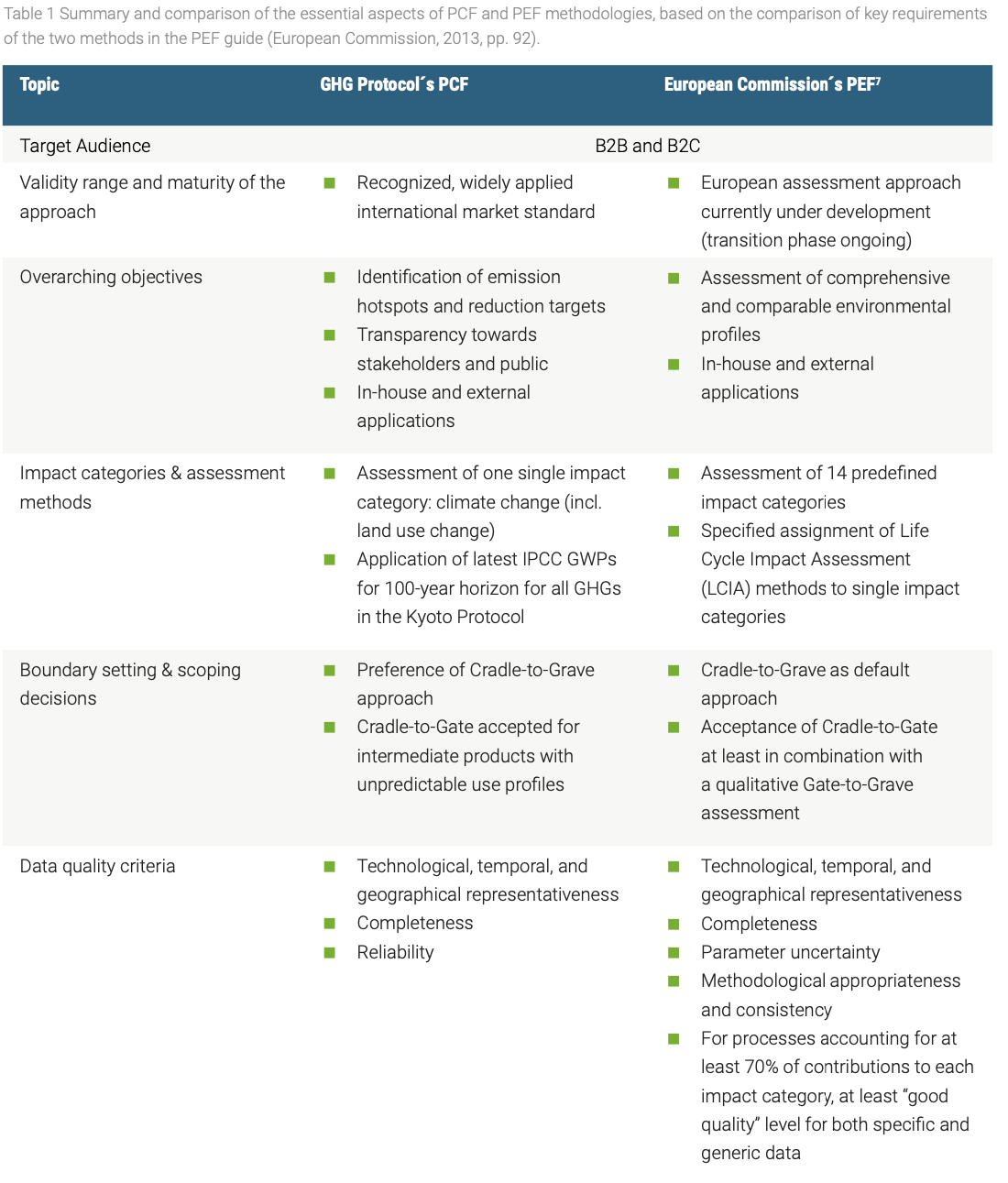
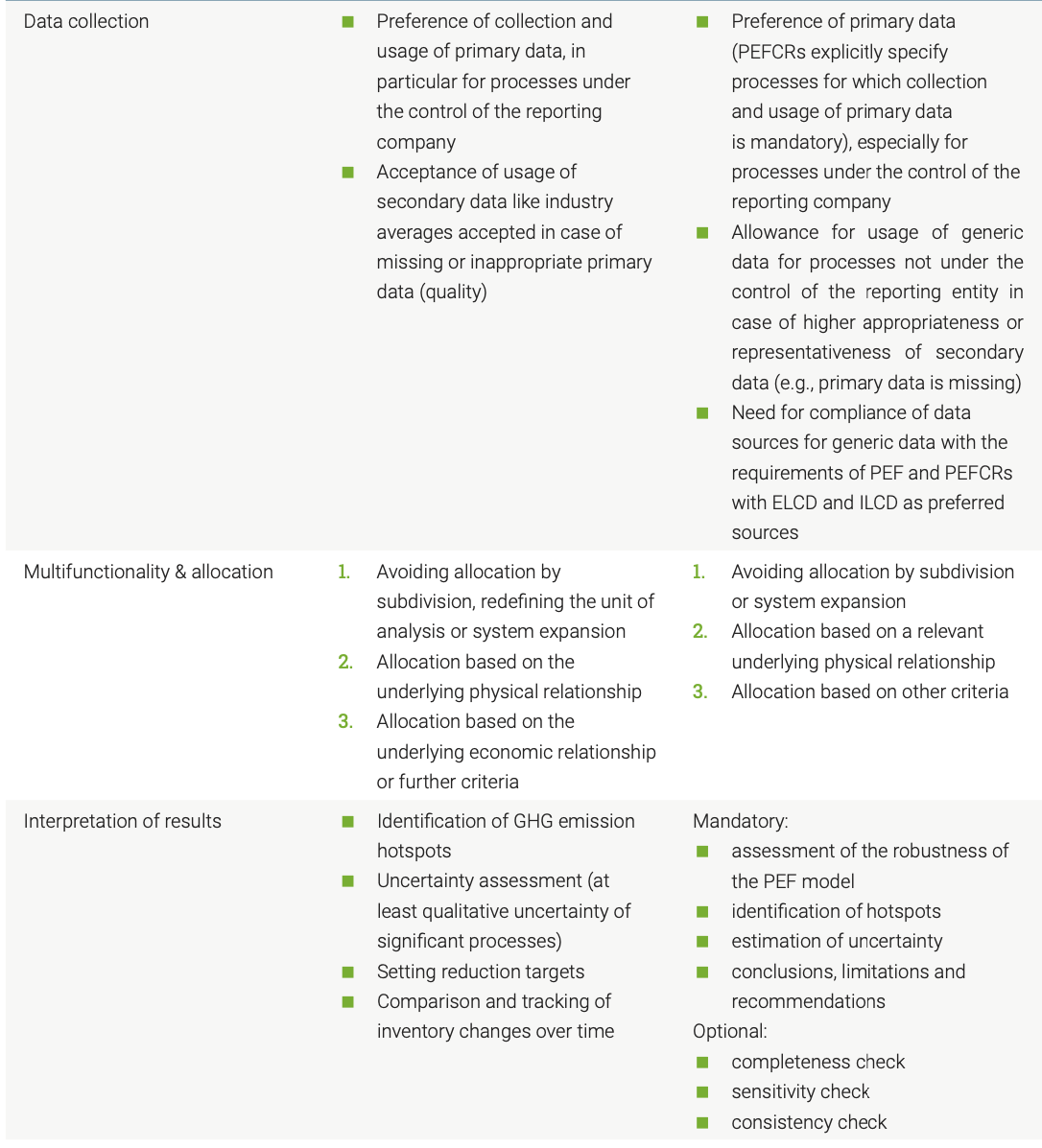
(7) Please note that all listed aspects refer to conduction of a basic PEF solely. Further specifications provided by PEFCRs are not included, unless mentioned explicitly.
4 Conclusion
Reporting the environmental impact of chemical products can be challenging but is becoming almost unavoidable due to the growing pressure from the client and regulatory sides at both the local and global level. To this end, chemicals companies can refer to already available standards, two of which are outlined in this paper. Guidance on how to proceed and even target comparable assessments, for example with the goal of upselling environmentally advantageous products, is provided by the two frameworks discussed. Particular challenges arising for chemicals companies during implementation of the two frameworks as well as possible actions for handling thereof can be found at the end of this section (cf. Table 2).
Achieving readiness at an early stage could be advantageous for firms, allowing them to meet clients’ expectations and enhancing competitiveness. Setting up a data platform for the attribution of sustainability KPIs at an early stage moreover offers further possibilities for optimization based on the impact analysis of single products or product portfolios, incentive schemes for management, transparent tracking of decarbonization paths and more. In any case, calculation of a product footprint should only be regarded as a first step to measure the status quo and set as well as track emission reduction targets.
Activities for emissions reduction in the climate change impact category are, inter alia, highly dependent on the provision of renewable energy and electrification, especially since reduction of total energy consumption is only a limited option for chemicals companies. Pilot plants for e-crackers and green ammonia production are only two examples for advancements that have already been initiated to substantially decrease the greenhouse gas emissions of chemicals. Long innovation and investment cycles for highly specific plants also contribute to the fact that setting and achieving reduction targets, especially in consideration of the time frame for the European Green Deal and the Chemicals Strategy, remain no easy tasks for the chemical industry.
Even with a fully functioning and comprehensive framework for reporting of sustainability KPIs, the task of achieving a greener chemistry remains a long way off. Innovation and optimization with respect to new criteria is also necessary to keep up with the ambitious targets set by the international strategic trends.
Hence, in the next decades the chemical industry will face many difficult challenges and at the same time probably also foster innovation of processes, corporate culture, and mindset. The establishment of profound and reliable standard procedures for the quantification of chemicals’ product environmental footprints will most probably be an essential building block for the transformation that lies ahead.
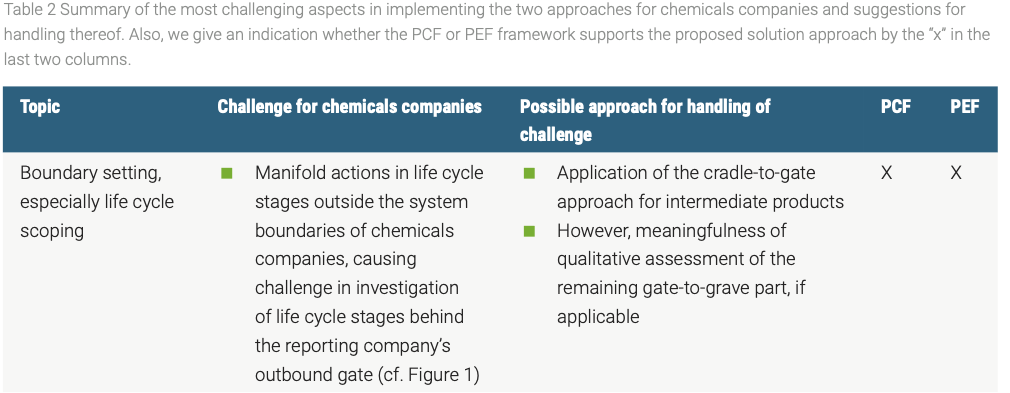
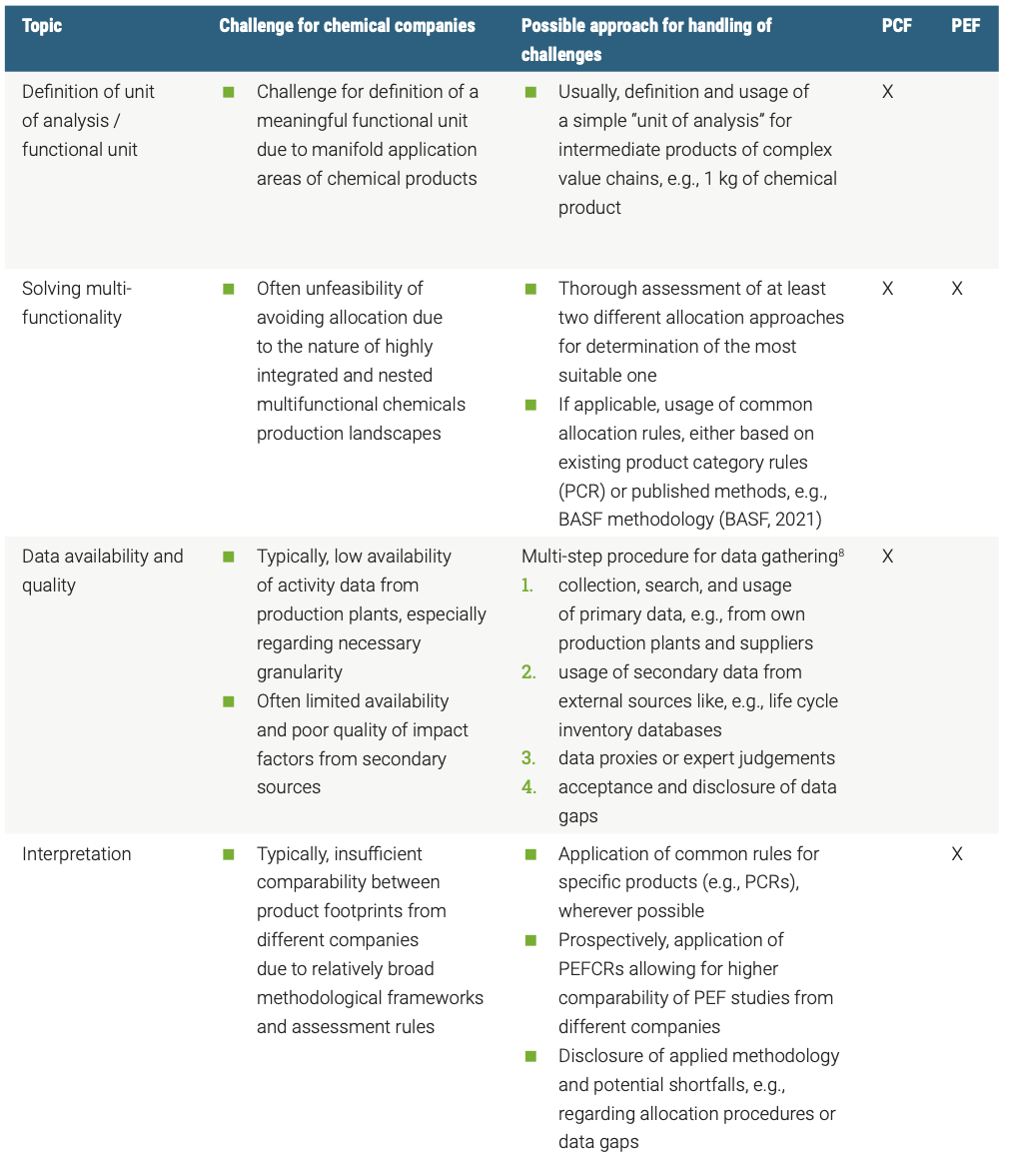
(8) Overall, comparably high data availability for the climate change impact category and thus, better prerequisites for solving this challenge through steps 01 – 03 within a PCF study.
5 List of abbreviations
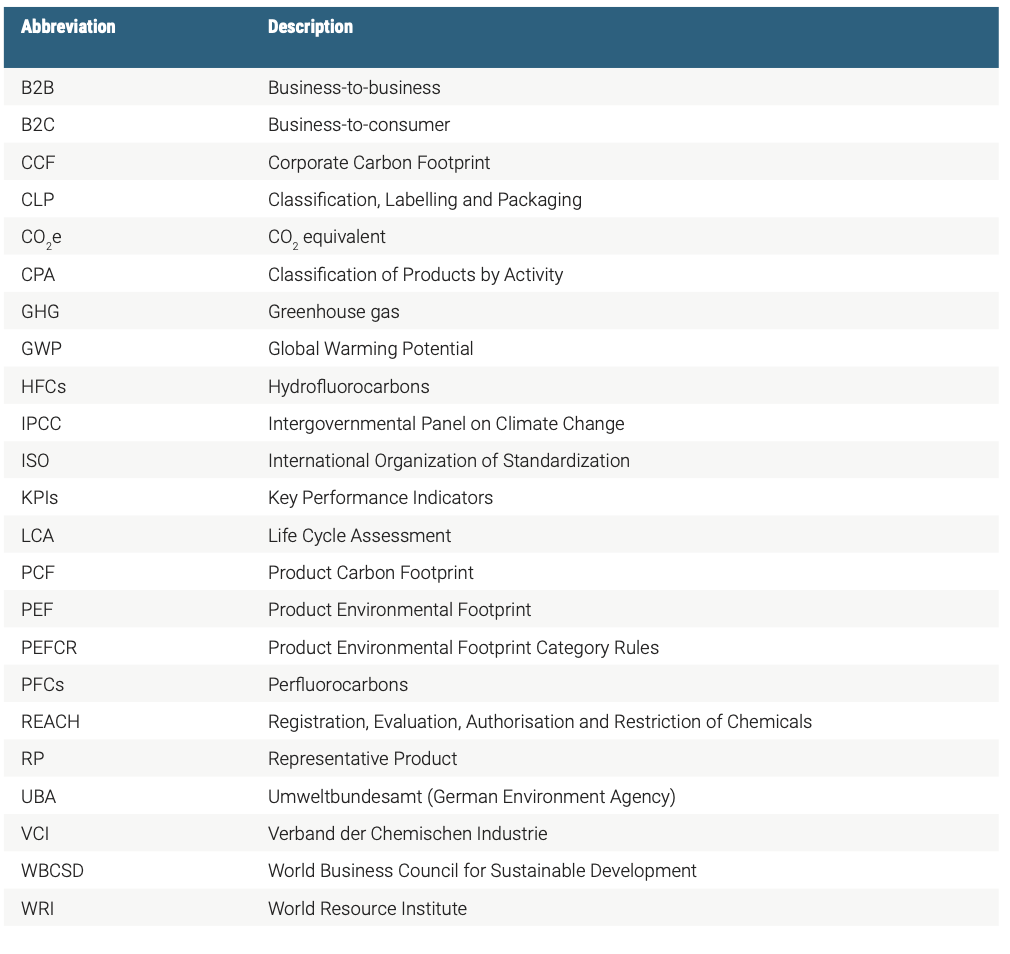
References
BASF (2021): BASF Methodology for Product Carbon Footprint Calculation, available at https://www.basf.com/global/documents/en/sustainability/we-drive-sustainable-solutions/quantifying-sustainability/product-carbon-footprint/MethodologyDocument.pdf, accessed 30 March 2022.
European Commission (2010): Joint Research Centre – Institute for Environment and Sustainability. International Reference Life Cycle Data System (ILCD) Handbook – General guide for Life Cycle Assessment – Detailed guidance, First edition March 2010. EUR24708, available at https://eplca.jrc.ec.europa.eu/uploads/ILCD-Handbook-General-guide-for-LCA-DETAILED-GUIDANCE-12March2010-ISBN-fin-v1.0-EN.pdf, accessed 30 April 2021.
European Commission (2013): 2013/179/EU: Commission Recommendation of 9 April 2013 on the use of common methods to measure and communicate the life cycle environmental performance of products and organisations Text with EEA relevance, available at https://op.europa.eu/en/publication-detail/-/publication/93cb8358-b80d-11e2-ab01-01aa75ed71a1#document-info, accessed 12 April 2021.
European Commission (2017): PEFCR Guidance document, – Guidance for the development of Product Environmental Footprint Category Rules (PEFCRs), version 6.3., available at https://eplca.jrc.ec.europa.eu/permalink/PEFCR_guidance_v6.3-2.pdf, accessed 12 April 2021.
European Commission (2018): The Environmental Footprint transition phase, available at https://ec.europa.eu/environment/eussd/smgp/ef_transition.htm, accessed 30 November 2021.
European Commission (2019): Suggestions for updating the Product Environmental Footprint (PEF) method, available at https://eplca.jrc.ec.europa.eu/permalink/PEF_method.pdf, accessed 12 April 2021.
European Commission (2020): COM/2020/667: Chemicals Strategy for Sustainability Towards a Toxic-Free Environment, available at https://ec.europa.eu/environment/pdf/chemicals/2020/10/Strategy.pdf, accessed 12 April 2021.
European Statistical Office (2008): Glossary: Statistical classification of products by activity, available at https://ec.europa.eu/eurostat/statistics-explained/index.php/Glossary:Statistical_classification_of_products_by_activity_(CPA), accessed 29 November 2021.
Greenhouse Gas Protocol (2004): A Corporate Accounting and Reporting Standard, revised edition. Greenhouse Gas Protocol, available at https://ghgprotocol.org/corporate-standard, accessed 12 April 2021.
International Organization for Standardization (2006): Environmental management—Life cycle assessment – Principles and framework, second ed., ISO 14040:2006, International Organization for Standardization, Beuth Verlag GmbH, Berlin
Umweltbundesamt (2012): Carbon Footprint – Teilgutachten „Monitoring für den CO2-Ausstoß in der Logistigkette“, available at https://www.umweltbundesamt.de/sites/default/files/medien/461/publikationen/430 : DSLV im Auftrag des Umweltbundesamtes, accessed 12 April 2021.
Umweltbundesamt (2018): Environmental Footprint: Der Umwelt-Fußabdruck von Produkten und Dienstleistungen Abschlussbericht, available at https://www.umweltbundesamt.de/sites/default/files/medien/1410/publikationen/2019-01-17_texte_76-2018_environmental-footprint_1.pdf, accessed 12 April 2021.
Verband der Chemischen Industrie e.V. (2021): Innovationsstandort Deutschland in Daten und Fakten, available at https://www.vci.de/ergaenzende-downloads/forschung-und-entwicklung-chemie-kurz.pdf, accessed 15 November 2021.